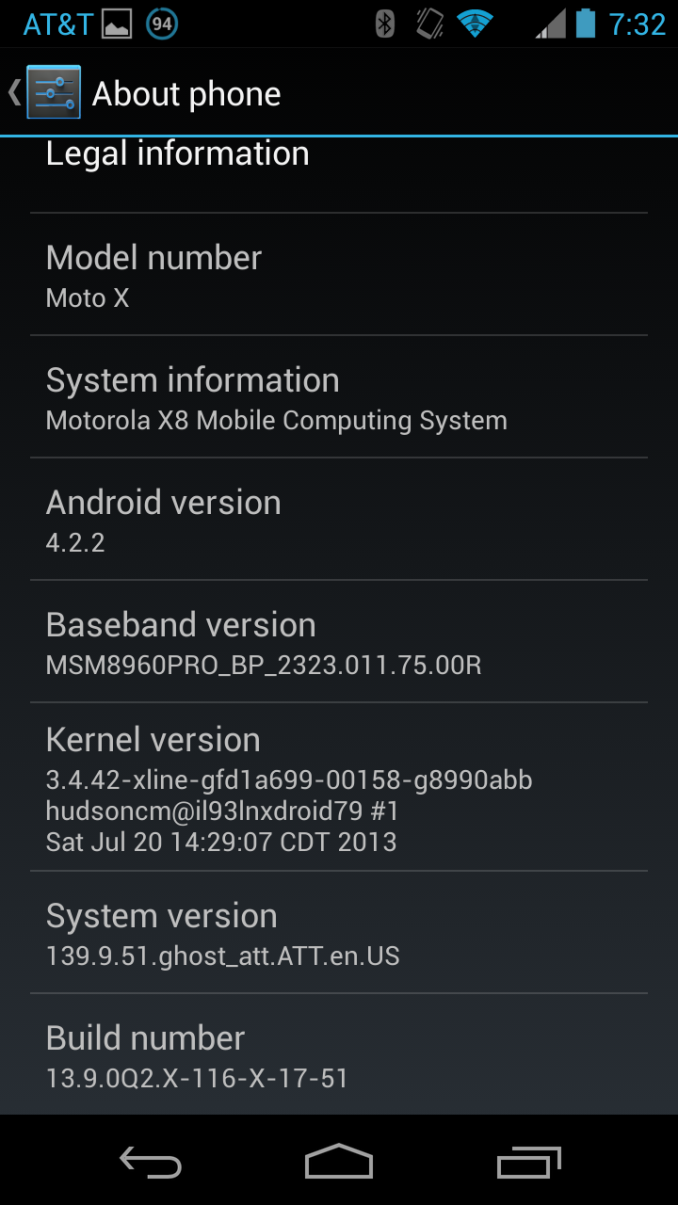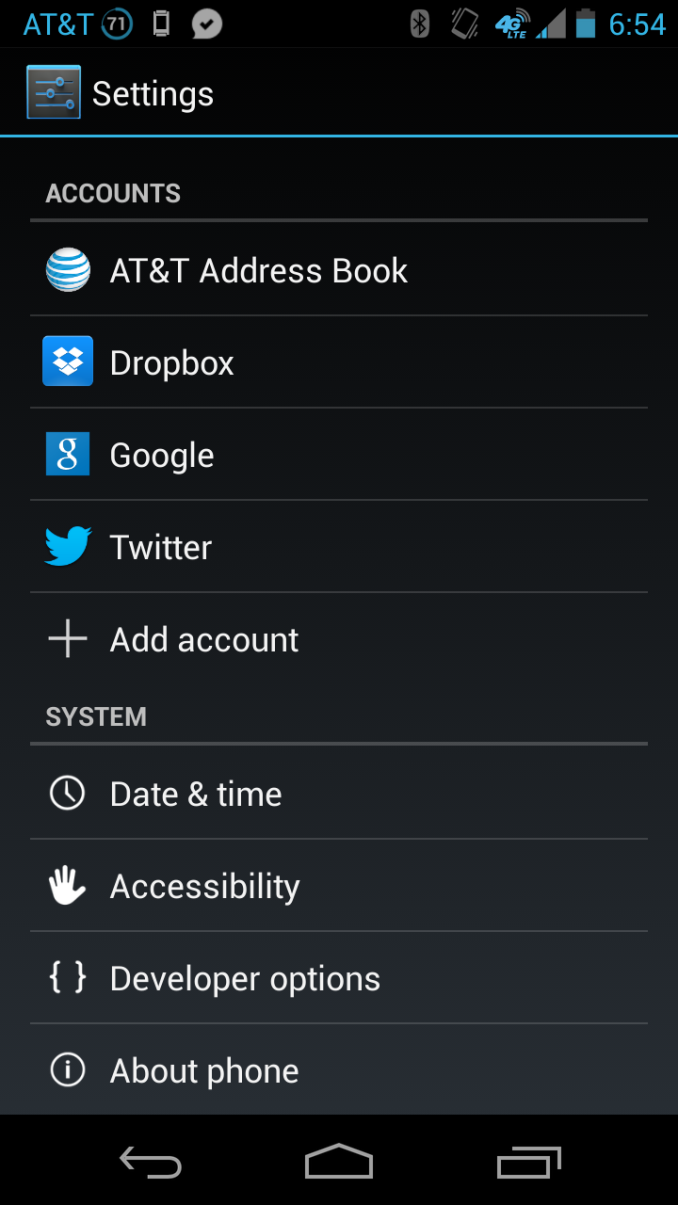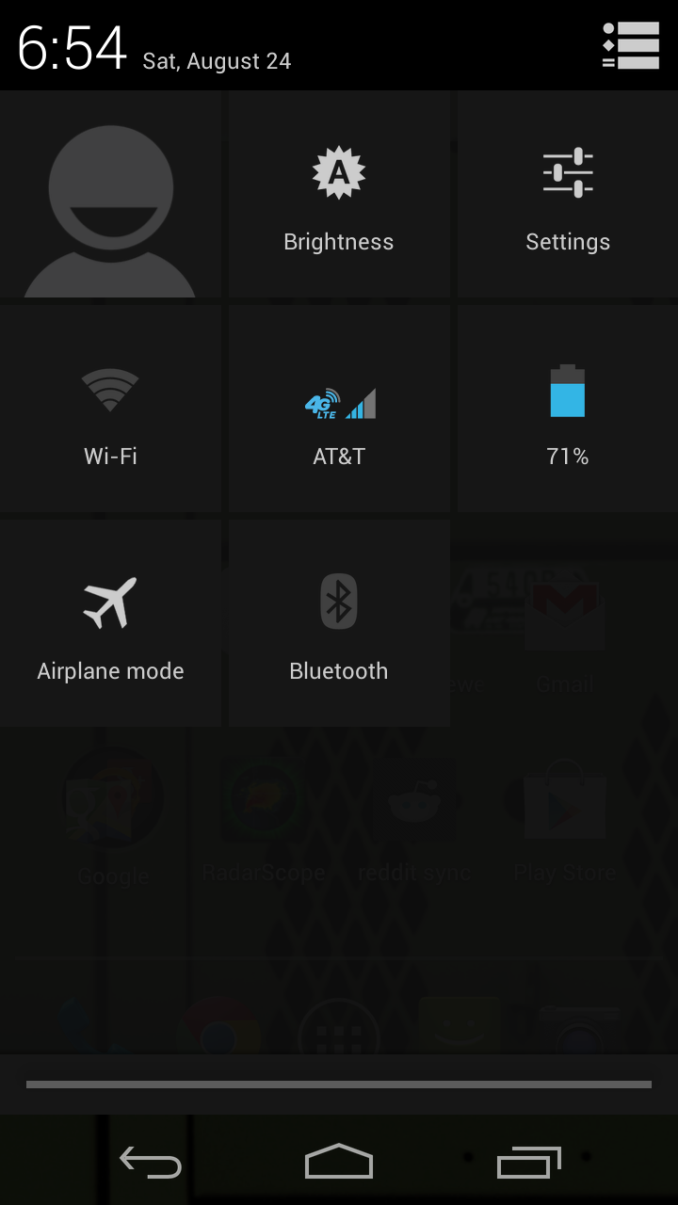Moto X Review
by Brian Klug on August 26, 2013 1:30 PM EST- Posted in
- Smartphones
- Qualcomm
- MSM8960
- Motorola
- Android
- Mobile
- Android 4.2
- Moto X
Somewhat Stock Android
One of the first things that changed for Motorola under its new Google ownership was the final nail through the coffin for Motoblur, with OTA updates for some of its handsets gradually scaling back customized features in favor of stock ones. I joked with Anand that Google paid $12.5 billion for Motorola just to kill the beast that was Motoblur. Truth be told the presence of largely-stock Android 4.x UI is perhaps one of the best qualities of the Moto X.
ro.build.version.full=Blur_Version.139.9.51.ghost_att.ATT.en.US
The Moto X at launch runs Android 4.2.2, which isn’t quite bleeding edge Android, but close. This is essentially an intentional side effect of the Google / Motorola firewalling that we’ve been told is in place. I’m not entirely surprised, but I had hoped the Moto X would differentiate itself by somehow launching with 4.3 considering other handset partners had the Jelly Bean MR2 (4.3) update a while ago, clearly Motorola should’ve as well. I know that Qualcomm had the BSP (Board Support Package) for 4.3 ready for MSM8960Pro at the same time as it did APQ8064, so I can’t think of any technical reason. Again I’d wager Moto X launching with 4.2.2 is entirely political, to say nothing of the usual operator testing nonsense in the USA.
Anyhow the homescreens (widget panels), launcher, settings menu, notification shade, dialer, and default applications are basically unadulterated Android. I say largely unadulterated because to say that the Moto X is entirely stock is still not quite true – there’s the operator name in the top left of the notification bar all the time, and the branded network status indicator (the cartoonish looking AT&T “4G” and “4G LTE” logos) on my AT&T unit. Unnervingly, the network status logo and bars are also a different shade of blue than the battery and time icons adjacent to it.
There’s also AT&T address book preloaded which cannot be removed, which is a huge annoyance. There’s also a provisioning check for bluetooth and WiFi tethering, another indication of an operator-touched device. There’s also AT&T my Wireless and AT&T’s visual voicemail app loaded, but those are pretty understandable.
The Moto X also has a few UI changes that definitely aren't stock. The status bar has different spacing for the cellular and WiFi indicator logos which carries over as a result of Blur (the spacing issue is just the "4G LTE" or similar status logo disappearing when on WiFi). Also the on-screen android buttons sometimes appear transparent, showing what's under, which definitely isn't a stock implementation.
My definition of stock is just that, totally stock – no branded logos, operator names everywhere, or any preloaded apps. Truth be told the Moto X isn’t stock, it just has the stock UI on top of a relatively standard Motorola software build, but it does have a heck of a lot less of the operator preload crapware that normally shows up on Android phones sold with a subsidy these days. Android’s visual style is now mature and appealing enough that it really doesn’t need customization or modification to look good, rather it just needs to be left alone as much as is politically possible. If there’s one thing the Moto X does that every other handset maker should take to heart, it’s exactly that.
If you’re on a wireless operator that can’t work with the newest Nexus phone or Google Play edition devices (like the CDMA ones in the USA – Verizon, Sprint, US Cellular), the Moto X might be the closest you can get to stock, even if it technically isn’t completely so. I suspect this will attract a lot of enthusiasts who are on other operators for their own reasons, even if the longer term solution really should be to vote with your wallet and move to an operator that’s open and compatible with those devices.














105 Comments
View All Comments
evilspoons - Monday, August 26, 2013 - link
It's too bad we don't get any of the customization options in Canada. Rogers is getting the Moto X, but I think it's just in three solid colours.jjj - Monday, August 26, 2013 - link
Maybe worth mentioning that Atmel has a "Sensor Hub" MCU and it's used in S4 and Surface at least but wasn't highlighted in the marketing so it got zero attention.Honest Accounting - Sunday, September 15, 2013 - link
Does this function without (waking up) the main CPU cores?nerd1 - Monday, August 26, 2013 - link
So called 'customization' has been available for samsung phones for AGES.Heck they even have freedom of customizing the battery sizes!
maltanar - Monday, August 26, 2013 - link
Nice review Brian, thanks. I have a feeling we'll be seeing more and more fixed-function or semi-specific accelerator hardware (read: "cores") in processors in the near future. Not just for mobile applications processors but (over a longer period) for desktop/laptop/server CPUs as well.tim851 - Monday, August 26, 2013 - link
"I’d posit that the optimal size is somewhere just shy of 5-inches diagonal, say between 4.7 and 5, but this is a subject of heated debate."If there's a heated debate, it should be a clue that there is NO OPTIMAL SIZE. People have different use cases for smartphones. I've seen many young girls with tiny hands and huge phones. They don't care for one-handed use. They stuff them in their purses.
I agree with the point about small screen shouldn't mean small specs.
retrospooty - Monday, August 26, 2013 - link
"If there's a heated debate, it should be a clue that there is NO OPTIMAL SIZE. People have different use cases for smartphones. "Exactly. It's totally user pref based. It's like asking what is the optimal automobile size. A guy that lives 50 miles from his work, would probably need a small car with good mileage, where a mother with ith 4 kids is better off with a minivan or SUV, and a construction worker needs a truck to haul things. Is one better than the other? No, unless you are talking to the commuter, mother or construction worker.
As for the phone, looks like a great midrange phone. I like alot of the things MOto is trying to do with it... Should be cheaper though.
scavio - Monday, August 26, 2013 - link
Why should it be cheaper? This isn't a Nexus.If they are lucky they are saving $10 on the SOC vs a Snapdragon 600. The screen might be a $20 savings (once again, if they are lucky). Everything else costs the same as the other flagships.
Impulses - Tuesday, August 27, 2013 - link
It would've been interesting as a low cost mid-cycle Nexus refresh tho, at like $250-300 (32GB if the latter maybe, with only one SKU)... But then the customization aspect would've been a nightmare (Nexus launches are flaky enough as it is, distribution is not Google's thing) and the theories about Google/Moto's impact on other OEM would've raised hell.BallGum - Tuesday, November 19, 2013 - link
It's almost more "Nexus" than a Nexus. I think the Motorola phones are almost as though Google tests features before they make it into Android. With 4.4 KitKat the whole thing is a bit more Googley.I know this sounds slightly outlandish, but it's explained better over at my Blog:
http://theballofgum.blogspot.co.uk/2013/11/motorol...